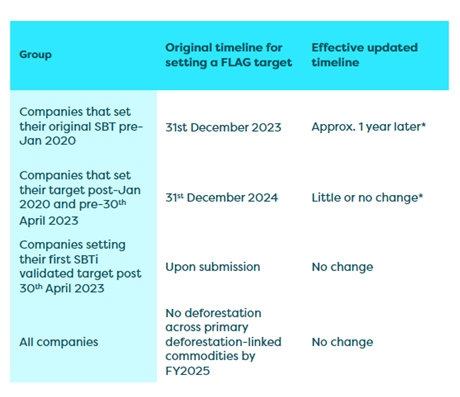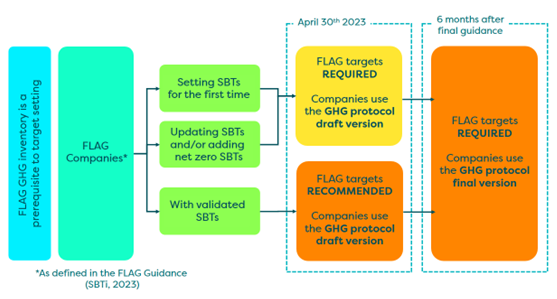SBTi changes the Forestry, Land use and Agriculture target implementation timeline (for some)

The SBTi recently revised the implementation timeline for forestry, land-use and agriculture (FLAG) target setting, linking it to the publication of the GHG Protocol’s long-awaited Land Sector and Removals guidance.
Leading companies with significant land sector impacts will be aware of the FLAG target setting guidance from the Science-based Target Initiative (SBTi) published in late 2022. With over a fifth of global GHG emissions resulting from agriculture, forestry and other land use, this guidance has been welcomed as a step toward establishing a consistent approach for demonstrating science-based reductions in emissions from these sectors.
A significant challenge to date has been the lack of an agreed standard for accounting for these emissions. This was partly addressed last year with the publication of the draft Land Sector and Removals Guidance from the GHG Protocol. However, the much-anticipated guidance remains in draft format, with the final version expected in “mid-2024”, although the date has already been pushed back several times.
Initial implementation timelines from the SBTi regarding the effective ‘start date’ for FLAG target setting were ambitious, with FLAG target setters categorised into three groups:

The revised timeline remains unchanged for companies setting targets for the first time, indeed this requirement is already in force. For those that already have SBTi-validated targets and are not seeking any updates – the timeline is now pegged to the GHG Protocol guidance publication as summarised in the diagram below:

Companies with targets set before 2020 have an extra year to make their FLAG target submission. But the requirement remains much the same for everyone else.
Based on a mid-2024 publication date for the GHG Protocol guidance, then the main impact of the change is that companies with targets set prior to 2020 have an extra year to make their FLAG target submission. For the rest, the requirement remains much the same – around the end of 2024.
All companies with significant land sector impacts are going to have to update their GHG inventories in line with the GHG Protocol Land Sector and Removals Guidance. This is irrespective of whether they choose to adopt SBTi Net Zero Corporate Standard validated targets or not.
SBTi target setting will require companies to split their GHG inventory into non-land and FLAG emissions. To set targets in confidence, companies will need to conduct separate pathway and target setting analyses. Progress on energy/industry and FLAG emission reductions will need to be reported separately and annually.
GHG inventories covering FLAG emissions are potentially complicated, so companies should allow plenty of time to complete them and do what they can now.
It’s important to set GHG targets against a robust emissions baseline and using calculation methodology that allow the impact of emission reduction initiatives to be visible. This will not be the case if the baseline is done with a heavy reliance on assumptions and simplistic approaches, such as ‘spend-based’ emission factors, common in less-sophisticated footprinting tools. GHG inventories covering FLAG emissions are potentially complicated, so companies should leave enough time to work through the issues.
The 6-month time window between the finalisation of the GHG Protocol guidance and the FLAG target requirement maybe short for the task in hand, particularly if it is out of sync with annual reporting cycles and little preparatory work has been done. We therefore recommend that all companies with validated SBTs and potentially significant land sector impacts use the current waiting time to get ahead as far as they can, by reviewing their GHG inventory in light of the SBTi’s FLAG target setting guidance and the draft GHG Protocol Land Sector and Removals guidance.
A useful exercise is to create an emissions projection based on the technical limit for FLAG reductions and to compare it to the SBTi’s minimum target ambition. This will gauge how much of a challenge meeting the targets is likely to be, and which emission sources are most problematic. It is also useful to identify if and where there is potential for carbon removals within the value chain. To include these in the GHG inventory will require measurement effort, which may take time to design and implement.
For companies already with validated targets for whom FLAG emissions sit in scope 3, the adoption of a FLAG target may lead to an increase in the reductions required in the near term. This is because the FLAG near-term target is based on a 3.03% linear reduction each year, as opposed to the minimum 2.5% reduction commonly referred to in existing energy/industrial scope 3 targets.
Here you can find a more detailed FAQ summary of the SBTi FLAG target setting guidance and associated draft GHG Protocol accounting guidance.
Click here to download a detailed FAQ summary
For further support, or any other queries on developing net zero strategy, please contact Tim Crozier-Cole, Head of Aim for Zero Corporates.
